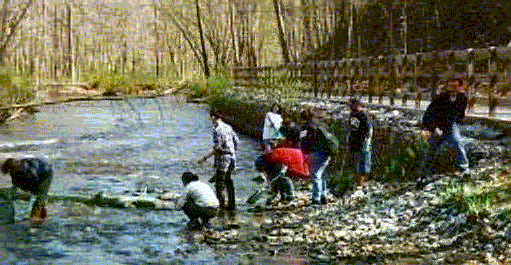


A note about
this page: All of the links provided below go to a source page which
lists where to find the addresses of these web sites. To find this, match
the image or topic you clicked on the source page. Thank you and good luck!
Temperature-
Due to variations in exposure to sunlight or thermal pollution from nearby
industries, the temperature of a river or stream may be raised.
pH-
The pH can change due to discharge from factories, excessive amounts of
pollution, or geographic events such as volcanic eruptions.
Oxygen
Content- The Oxygen content of any river body may change from the
temperature of the water, or a rapid change in elevation such as a waterfall.
Another way Oxygen content may be raised is the presence of rapids or "white
water" this term described the churning of air into the water, therefore
the Oxygen content goes up.
Erosion-
Erosion takes place at the place in a body of water (usually a river) where
it begins to turn. Erosion also takes place along the sides of the river.
Deposition-
The counterpart to Erosion where the sediments removed by erosion are deposited.
This usually occurs where the river finishes a turn of changes the direction
of a turn.
Runoff-
Depending on the landscape, runoff may have a strong or little influence
on water quality. If the source of the runoff is uphill from the final
destination, much runoff will occur. If the source is on an even level
or downhill from the destination, the opposite is true.
Total
Solids- The amounts of these increase with the presence of industry,
geological events like land or mud slides, and high erosion.
Pollution
(Overall)- There are several ways in which the pollution level
of a body of water may change according to the surrounding topography.
Pollution
(Organisms)- The type of organisms found in different parts of
water bodies are usually good indicators of the pollution levels in the
water. As mentioned before, nearby factories or production facilities may
pollute the water allowing different types of macro-invertebrate life.
The concentration and type of organisms directly change with the amount
of pollution present, which is directly related to the water's location
and geographical features that "filter out" pollution.
B.O.D.-
Because different topographical features influence higher or lower amounts
of pollution, different organisms and plants may be present in different
places in a water body, thus affecting the biological oxygen demand(B.O.D).
In areas with high B.O.D., it is difficult for larger animals to attain
Oxygen. Furthermore, in places with low B.O.D., Oxygen is more plentiful.
Source
List- A list of the links and sources provided in this series of
web pages.
Yes. In fact,
many individual factors that contribute to the quality of water are strongly
impacted by topographical features. These factors are listed, followed
by a brief description on how they are changed.






